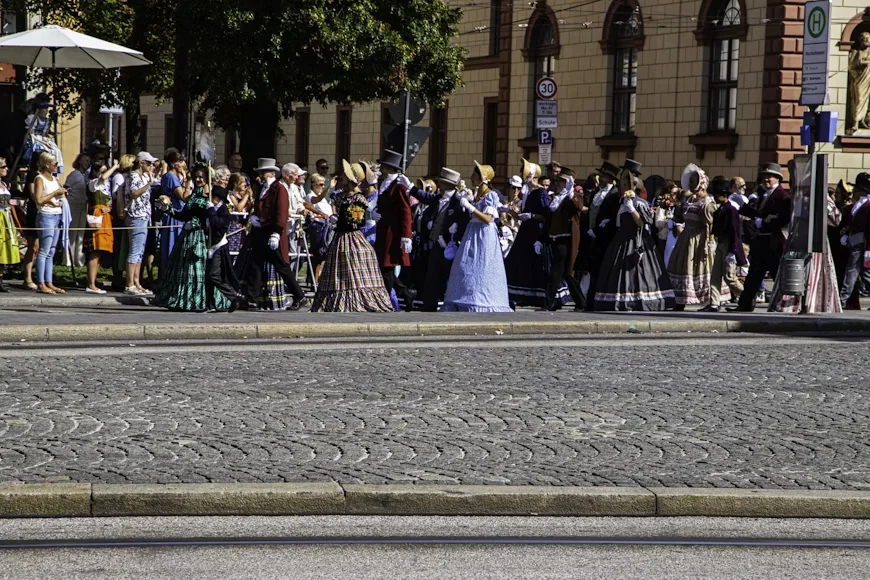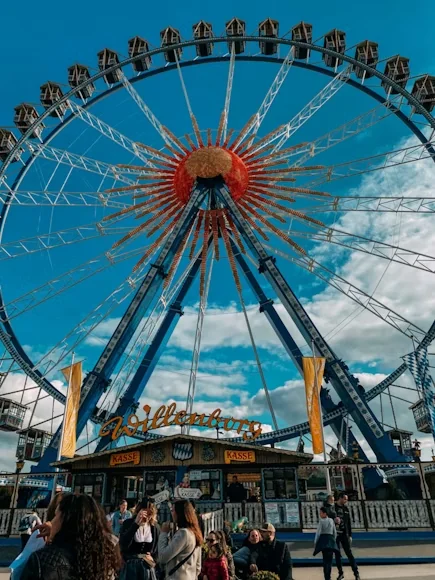Oktoberfest is the biggest beer festival on the planet, but there’s much more going on than just raising a glass. Born out of a royal wedding over 200 years ago in Munich, it has grown into a feast for all senses, showing off the colourful traditions of Bavaria.
Today, Oktoberfest attracts people from across the globe. It isn’t simply about beer; it’s a vibrant chance to enjoy Bavarian folk culture with traditional outfits, oompah music, classic foods, energetic dances, and lively parades.
What started as a one-off celebration has blossomed into a full-scale festival, keeping Bavarian heritage alive and buzzing for visitors from every corner of the world.
Table of Contents
ToggleThe Origins and Evolution of Oktoberfest
Oktoberfest all began on 12 October 1810 with a grand celebration in Munich—an open invitation for everyone in the city to join Crown Prince Ludwig’s wedding to Princess Therese of Saxe-Hildburghausen. That day wasn’t just about royal romance; it was the start of what would grow into Bavaria’s most famous annual tradition. The earliest festivities centred around lively horse races, watched by the royal family on fields soon named Theresienwiese after the princess, where the party still happens every year.
Over the next two hundred years, what started as a regional gathering transformed into an international sensation. The change is obvious: old horse races and modest agricultural shows gave way to rows of beer stands, which eventually turned into the huge beer tents Munich is now known for. By the late 1800s, the festival’s entertainment and food scene had grown to match the ever-increasing crowd.
Today, Oktoberfest welcomes visitors from every corner of the globe. The attraction isn’t just the well-poured Bavarian beer—people come for the colourful parade processions, classic folk dances like the ‘Schuhplattler’, and the must-have Lederhosen and Dirndl outfits. From its royal beginnings, Oktoberfest now stands as an international celebration of tradition, food, music, and genuine Bavarian cheer.
Cultural Symbols and Attire
Lederhosen for men and Dirndl for women aren’t just outfits you dust off for Oktoberfest—they’re treasured badges of Bavarian identity. Lederhosen, crafted from leather, and the Dirndl, with its bodice, blouse, skirt, and apron, each have roots deep in Bavarian life. Once standard daily dress for rural folk, these clothes now proudly show off the region’s spirit and past.
By slipping into traditional Bavarian gear, festivalgoers actively connect with generations gone by. You’re not just slipping on a costume; you’re helping keep a vibrant tradition alive. Each stitched pattern and colourful trim often hints at the wearer’s home village, making these costumes as personal as they are festive.
At Oktoberfest, people in Lederhosen and Dirndl create a sea of colour, uniting guests and locals in a shared sense of celebration. Wearing them turns everyone into part of the story, showing that Oktoberfest is more than a massive party—it’s a heartfelt nod to Bavaria’s lively culture and history.
Musical and Dance Traditions
Oompah bands are at the centre of Oktoberfest’s unmistakable buzz. Decked out in colourful Trachten, they fill every corner with bouncy brass tunes and the squeeze of accordions, instantly lifting everyone’s spirits. Their music isn’t just a soundtrack; it’s what gets people clapping, laughing, and singing arm in arm, no matter where you’re from.
With the room alive and steins in hand, the enthusiastic rhythms practically beg you to join in. Whether you’re belting out a chorus or feet-shuffling to the beat, the whole crowd gets swept up in the fun.
Traditional dances like the ‘Schuhplattler’ are another highlight. Picture the men slapping their shoes and thighs in time, while the women whirl around in vibrant skirts. It’s loud, it’s energetic, and it’s impossible not to smile while watching—or having a go yourself.
These dances aren’t just a spectacle; they’re how Bavarians celebrate who they are and where they’ve come from. Every slap and spin keeps old traditions shining, giving everyone at Oktoberfest a chance to see and join in with authentic Bavarian culture, long after the music fades.
Bavarian Cuisine and Gastronomy
Oktoberfest is legendary not just for what’s in your stein, but for what’s on your plate. Anyone who’s ever joined the festivities knows that the festival is a food lover’s playground, packed with hearty Bavarian classics that can make any visitor’s eyes widen and mouth water.
You’ll spot bratwurst sizzling on the grill, filling the air with that irresistible smoky aroma. These juicy sausages, usually served with a dollop of mustard, are a must-try—quick, simple, and completely satisfying. Pretzels are just as popular, with their crispy crust and fluffy centre, sprinkled with coarse salt; perfect alongside a cold beer, or honestly, even on their own for a quick nibble.
And then there’s Schweinshaxe—the mighty pork knuckle. Its crackling skin and tender meat draw crowds, usually paired with potatoes or tangy sauerkraut. It’s one of those comfort foods that goes down well whether you’re a local or just visiting.
Go beyond the hits and you’ll find plenty of other traditional favourites too: cheesy Käsespätzle (think German mac and cheese), a whole array of sausages, and plenty more dishes that showcase just how diverse Bavarian cooking can be. If you love food with big flavours and plenty of heart, Oktoberfest is like a welcoming invitation to tuck in and try it all.
Parades and Historical Pageantry

Oktoberfest parades are spectacles you won’t want to miss, bursting with colour and local pride. Crowds line the streets to watch processions featuring men in crisp Lederhosen and women twirling in bright Dirndls, each outfit a living link to Bavarian history. These aren’t just costumes—they’re part of the community’s story, bringing past traditions to life for a modern audience.
Horses decked with bells and ribbons pull beautifully decorated beer wagons, a nod to the days when beer arrived by cart rather than lorry. It’s a scene that’s straight out of an old folk painting, but the joy and enthusiasm from the crowd prove these traditions still matter.
Whether it’s the detail in a hat feather or the cheerful clink of tankards, the parade is both a tribute and a celebration. Every step, song, and smile invites festivalgoers and locals alike to feel part of something older and bigger than any single celebration—reminding everyone that at Oktoberfest, history isn’t just remembered, it’s paraded through the streets.
Beyond Beer: Entertainment and Attractions

There’s far more to Oktoberfest than oompah bands and overflowing beer mugs. The entire festival bursts with entertainment for all ages. The fun fair is a crowd favourite, filled with heart-racing rides and attractions. You’ll find roller coasters, Ferris wheels, and classic carousels for anyone hungry for a thrill, but there are also gentler rides set aside for little ones or those who prefer something a bit more sedate.
A highlight for many is the flea circus—a tiny, light-hearted show that’s managed to charm children and adults alike for generations. This oddball act has become a nostalgic treat, blending humour and a bit of old-fashioned fun.
For an even bigger range of fun things you can experience at Oktoberfest besides drinking beer, options go well beyond the main rides, as the fairgrounds are dotted with game stalls, from old-school hoop toss to shooting galleries and flashy, interactive games. It’s the sort of place where friendly competition is welcomed and there are plenty of chances to walk away with a cheesy prize.
Thanks to this mix of attractions and amusement, Oktoberfest is a hit with families. While grown-ups may spend time inside the beer tents, there’s plenty for kids and non-drinkers to discover. With something for everyone, it’s no wonder entire families keep coming back for a day packed with shared laughs and Bavarian spirit.
Oktoberfest as a Cultural Custodian
Oktoberfest plays a key role in keeping Bavarian culture alive and kicking. It’s much more than just a place to enjoy beer; every year, it brings together time-honoured customs and lets them shine against a modern backdrop. While the world seems to grow more similar, Oktoberfest makes sure Bavaria’s own character still stands out.
From traditional music and energetic dancing, to hearty food and classic dress, every aspect of the festival helps keep Bavaria’s uniqueness strong. These shared experiences help make sure old stories, recipes, and tunes don’t quietly disappear—they’re front and centre, celebrated with cheer and pride.
Six million visitors head to Munich for Oktoberfest each year, while millions more join in at copycat parties across the globe. That wide appeal shows Oktoberfest isn’t just for Bavarians or even Germans—it’s a highlight in the international diary for anyone who values celebration, community, and culture. Through lively parades, folk songs, and playful dances, the festival lets everyone get hands-on with Bavarian traditions, often without even setting foot in Germany.
So instead of sitting behind museum glass, Bavarian culture is lived, sung, and tasted by people from all walks of life—making sure the stories, styles, and songs of the region carry on beating strongly for the next generation.
